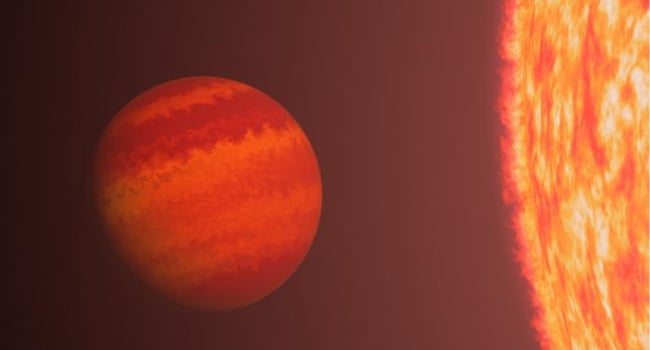
NASA discovers unique exoplanet that baffles astronomers
NASA's Transiting Exoplanet Survey Satellite (TESS) has identified a peculiar planet that has baffled astronomers. Despite being relentlessly bombarded with radiation from its red giant parent star, the exoplanet, named Phoenix, has remarkably retained its atmosphere. Phoenix, officially designated TIC 365102760 b, is smaller, older, and hotter than previously thought possible for a planet of its kind, Space.com reports.
Located about 1,800 light-years from Earth, Phoenix orbits its star, TIC 365102760, at a perilously close distance of 5.6 million miles, resulting in a year that lasts just 4.2 Earth days. This proximity should have stripped the planet of its atmosphere, reducing it to a barren rock. Instead, Phoenix has defied expectations by maintaining a puffy atmosphere, a phenomenon that has intrigued scientists.
Phoenix belongs to a rare class of planets known as "hot Neptunes," which are larger than Earth but smaller than Jupiter and typically orbit close to their host stars. Despite being around 10 billion years old, Phoenix's endurance will eventually falter; researchers predict it will spiral into its giant star within the next 100 million years.
"This planet isn't evolving the way we thought it would," said Sam Grunblatt, the team leader and astrophysicist at Johns Hopkins University. "It appears to have a much bigger, less dense atmosphere than we expected for these systems. How it held on to that atmosphere despite being so close to such a large host star is the big question."
The discovery of Phoenix not only highlights the diversity of exoplanets but also offers insights into the evolution of planetary systems. TIC 365102760, the red giant star, has spent approximately 10 billion years converting hydrogen to helium. As the hydrogen depleted, the star's core collapsed, and its outer layers expanded significantly.
With a radius about 6.2 times that of Earth and a mass approximately 20 times greater, Phoenix has an unexpectedly low density, about 60 times less than the densest hot Neptune known. This suggests that some unknown process is slowing the atmospheric stripping typically expected for such close-orbiting planets.
The findings could also have implications for Earth's distant future. As Grunblatt explained, "We don't understand the late-stage evolution of planetary systems very well. This is telling us that maybe Earth's atmosphere won't evolve exactly how we thought it would." The Sun is expected to undergo a similar red giant transformation in about 5 billion years, potentially engulfing the inner rocky planets, including Earth.
The discovery, published in The Astrophysical Journal, showcases TESS's ability to detect smaller, less dense planets. This breakthrough has already led to the observation of dozens of smaller worlds, with ongoing efforts to better understand planetary atmospheres and their evolution over time.
- Related News
- Will the Earth survive a nearby supernova explosion?
- Perseverance discovers unusual rocks that look like popcorn on Mars
- ‘This innovation will change the world:’ Elon Musk confirms Starlink mini to be twice as cheap and fit in a backpack
- Scientists discover curious star that crosses Milky Way at speed of 2.1 million km/h
- Huge black hole suddenly awakens in constellation Virgo: It is million times more massive than the Sun
- The Sun's magnetic field is about to flip: What does it mean and what to expect?
- Most read
month
week
day
- In the future, smartphones will disappear, instead there will be brain implants: Elon Musk’s predictions 1003
- ‘This innovation will change the world:’ Elon Musk confirms Starlink mini to be twice as cheap and fit in a backpack 775
- Strange iPhones without camera appear online: Are they for nuclear power plant workers? 739
- Fusion technology breakthrough: China unveils first commercial “artificial sun” (photo) 710
- Huge black hole suddenly awakens in constellation Virgo: It is million times more massive than the Sun 676
- Perseverance discovers unusual rocks that look like popcorn on Mars 658
- What problems can arise in children from playing too much of the popular game Hamster Kombat? 619
- Gen-3 Alpha: Runway introduces AI generator for realistic videos 613
- Apple is ready to open access to NFC on iPhone, but only in the EU 603
- iOS 18 update makes iPhone 25% more powerful 583
- Archive
